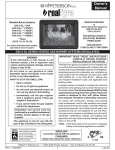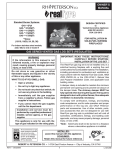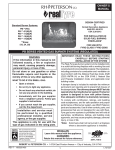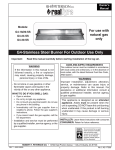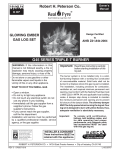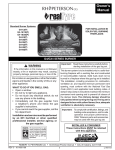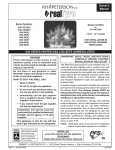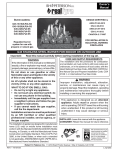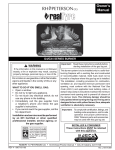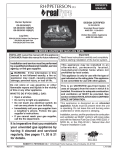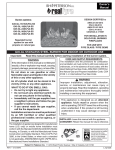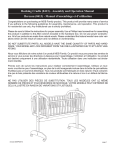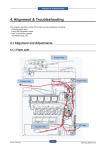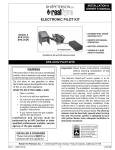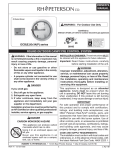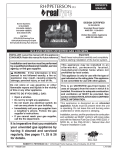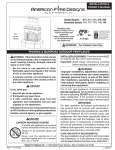Download G45 Series Burner - Hansen Wholesale
Transcript
OWNER’S MANUAL Standard Burner Systems: DESIGN CERTIFIED G45-**(P)A G45-**-01(M)(P) G45-**-11(M)(P) G45-**-15(M)(P) G45-**-17(M)(P) to Vented Decorative Appliance ANSI Z21.60-2012 CSA 2.26-2012 **Sizes: (16/19, 18/20, 24, 30, 36) FOR INSTALLATION IN SOLID-FUEL BURNING FIREPLACES* For indoor stainless steel models; add (-SS) to end of model # G45 SERIES VENTED GAS LOG SETS (REGULATED) IMPORTANT: READ THESE INSTRUCTIONS CAREFULLY BEFORE STARTING INSTALLATION OF THE LOG SET WARNING If the information in this manual is not followed exactly, a fire or explosion may result, causing property damage, personal injury, or loss of life. The Real-Fyre gas log set is to be installed only in a solid-fuel burning fireplace with a working flue and constructed of noncombustible material.The installation, including provisions for combustion and ventilation air must conform with the National Fuel Gas Code, ANSI Z223.1/NFPA 54, or the CSA B149.1, Natural Gas and Propane Installation Code, and applicable local building codes. A damper clamp is included to maintain the minimum permanent vent opening and to prevent full closure of the damper blade. The chimney damper MUST be fully opened when burning the log set.The log set is designed to burn with yellow flames; thus adequate ventilation is absolutely necessary. To comply with certification, listings, and building code acceptances, and for safe operation and proper performance of this log set, use ONLY Peterson parts and accessories. Use of other controls, parts, and accessories that are not designed for use with Real-Fyre gas log sets is prohibited and will void all warranties, certifications, listings, and building code approvals, and may cause property damage, personal injury, or loss of life. *Note: Solid-fuels shall not be burned in a fireplace where a decorative appliance is installed. Do not store or use gasoline or other flammable vapors and liquids in the vicinity of this or any other appliance. WHAT TO DO IF YOU SMELL GAS: • Open a window. • Do not try to light any appliance. • Do not touch any electrical switch; do not use any phone in the building. • Immediately call the gas supplier from a neighbor’s phone. Follow gas supplier’s instructions. • If you cannot reach the gas supplier, call the fire department. Installation and service must be performed by a qualified professional installer, service agency, or the gas supplier. This appliance is only for use with the type of gas indicated on the rating plate. INSTALLER: Leave this manual with the appliance. CONSUMER: Retain this manual for future reference. 11-020 ROBERT H. PETERSON CO. • 14724 East Proctor Avenue • City of Industry, CA 91746 REV 5 - 1301080756 1 L-A2-208 manuel des propriétaires Systèmes standard de brûleur: G45-**(P)A G45-**-01(M)(P) G45-**-11(M)(P) G45-**-15(M)(P) G45-**-17(M)(P) CONCEPTION CERTIFIÉE à Vented Decorative Appliance ANSI Z21.60-2012 CSA 2.26-2012 **Sizes: (16/19, 18/20, 24, 30, 36) POUR L’INSTALLATION EN CHEMINÉES BRÛLANTES DE COMBUSTIBLE SOLIDE* Pour les modèles d'intérieur d'acier inoxydable ; ajoutez (-SS) à l'extrémité du modèle # LA SÉRIE G45 A EXHALÉ LA NOTATION DE GAZ RÉGLÉE (RÉGLÉ) IMPORTANT: L I S E Z C E S I N S T RU C T I O N S SOIGNEUSEMENT AVANT DE COMMENCER L'INSTALLATION DE L'ENSEMBLE DE NOTATION. L'ensemble de notation de gaz d'Real-Fyre doit être installée seulement dans une cheminée brûlante de combustible solide avec une conduite de cheminée fonctionnante et être construit avec du matériel noncombustible. L'installation, y compris des dispositions pour l'air de combustion et de ventilation doit se conformer au code national de gaz de carburant, la norme ANSI Z223.1/NFPA 54, ou le CSA B149.1, code d'installation de gaz naturel et de propane, et codes du bâtiment locaux applicables. Une bride plus humide est incluse pour maintenir l’ouverture permanente minimum de passage et pour empêcher la pleine fermeture de la lame plus humide. L’amortisseur de cheminée DOIT être entièrement ouvert en brûlant la notation réglée. L’ensemble de notation est conçu pour brûler avec les flammes jaunes; ainsi à ventilation proportionnée est absolument nécessaire. Pour se conformer à la certification, les listes, et les acceptations de codes du bâtiment, et pour l'exploitation sûre et l'exécution appropriée de cet ensemble de notation, utilisent SEULEMENT des pièces et des accessoires d'Peterson. L'utilisation d'autres commandes, pièces, et accessoires qui ne sont pas conçus pour l'usage avec des ensembles de notation de gaz d'Real-Fyre est interdite et videra toutes les garanties, certifications, listes, et approbations de codes du bâtiment, et peut causer des dégats matériels, le dommage corporel, ou des pertes humaines. *Note: des Plein-carburants ne seront pas brûlés dans une cheminée où un appareil décoratif est installé. AVERTISSEMENT Si l’information en ce manuel n’est pas suivie exactement, une incendie ou une explosion peut résulter, entraînant des dégats matériels, des blessures, ou la perte de la vie. Ne stockez pas ou n’employez pas l’essence ou d’autres vapeurs et liquides inflammables à proximité de ceci ou d’aucun autre appareil. CE QUI À FAIRE SI VOUS SENTEZ LE GAZ: • Ouvrez une fenêtre. • N’essayez pas de n’allumer aucun appareil. • Ne touchez aucun commutateur électrique; n’utilisez aucun téléphone dans le bâtiment. • Appelez immédiatement le fournisseur de gaz du téléphone du voisin. Suivez les instructions du fournisseur de gaz. • Si vous ne pouvez pas atteindre le fo u r n i s s e u r d e g a z , a p p e l e z l e département de feu. L’installation et le service doivent être assurés par un installateur qualifié et professionnel, l’agence de service, ou le fournisseur de gaz. Cet appareil sert seulement avec le type de gaz indiqué de la plaque de contrôle. INSTALLATEUR : Laissez ce manuel avec l'appareil. CONSOMMATEUR: Maintenez ce manuel pour la future référence. 11-020 ROBERT H. PETERSON CO. 14724 East Proctor Ave., City of Industry, CA 91746 , USA REV 5 - 1301080756 2 L-A2-208 TABLE OF CONTENTS 4 5 5 6 6 7 8 9 9 10 11 12 14 14 14 15 17 19 21 23 24 25 26 PARTS LIST SAFETY CONTROL SYSTEM FOR MANUAL SERIES SAFETY CONTROL SYSTEM FOR 17 SERIES SAFETY CONTROL SYSTEM FOR 15 SERIES SAFETY CONTROL SYSTEM FOR 01 SERIES SAFETY CONTROL SYSTEM FOR 11 SERIES IMPORTANT INFORMATION INSTALLATION INSTALLING THE BURNER GRANULE, EMBER, AND GRATE PLACEMENT 01 VALVE MODELS ONLY LOG PLACEMENT OPTIONAL CHARRED SERIES INSTALLATION GLOWING EMBERS PLACEMENT LOG PLACEMENT LIGHTING INSTRUCTIONS - MANUAL PILOT AND SERIES 17 VALVE LIGHTING INSTRUCTIONS - SERIES 15 VALVE LIGHTING INSTRUCTIONS - SERIES 01 VALVE LIGHTING INSTRUCTIONS - SERIES 11 VALVE PILOT BURNER ADJUSTMENT TROUBLESHOOTING FLAME DESCRIPTION WARRANTY REV 5 - 1301080756 3 L-A2-208 PARTS LIST The log set is purchased and packaged separately. Golden Oak Designer Plus log set (RDP-24) shown here. Styles and sizes will vary depending upon the log set ordered. If the log set ordered includes placement instructions; follow those instructions. When ordering replacement parts; be sure to indicate your log set model. Item Description 1. 2. 3. 4. 5. 6. 7. 8. 9. 10. or 11. 12. or 13. 14. or 15. 16. 17. Rear log Front log Middle left log Middle right log Top left log Top right log Top center log Grate Log locator (with screws & nuts) Standard burner pan Stainless steel burner pan Flame diverter bracket Fuel injector (for natural gas only) Air mixer (for propane gas only) Control valve system (see insets) Select sand granules (natural gas only) Vermiculite granules (propane only) Embers Damper clamp Connector kit (with adapter) Manual valve 13 Series 11 Note: Photos not to scale. 7 13 6 5 3 Series 15 4 9 1 14 13 2 Series 17 13 Control valve (see insets) 8 13 Series 01 17 10 (Standard burner pan shown) 11 15 16 REV 5 - 1301080756 12 13 For all valves, see detailed information on the following pages. 4 L-A2-208 SAFETY CONTROL SYSTEM FOR MANUAL SERIES Pressure tap 4 5 Item Description 2 1. 2. 3. 4. or 5. or 3 1 Control knob w/ extension Manual SPK valve heat shield kit Pressure regulator, natural gas Pressure regulator, propane gas Pilot assembly, natural gas Pilot assembly, propane gas SAFETY CONTROL SYSTEM FOR 17 SERIES 2 4 3 1 Remote connects here 5 Item Description 1. 2. or 3. 4. or 5. 6. REV 5 - 1301080756 Valve Pilot assembly, natural gas Pilot assembly, propane gas Heatshield kit Pressure regulator, natural gas Pressure regulator, propane gas Control knob w/ extension Remote kit (if equipped) 6 All replacement parts may be obtained from the nearest Real-Fyre® dealer. For assistance in locating a dealer, you may contact the address listed on the front page. 5 L-A2-208 SAFETY CONTROL SYSTEM FOR 15 SERIES 1 2 3 6 4 Item Description 1. 2. or 3. or 4. or 5. 6. 5 Heatshield kit Pressure regulator, natural gas Pressure regulator, propane gas Pilot assembly (natural gas) Pilot assembly (propane gas) Valve, natural gas Valve, propane gas Remote kit (if equipped) Decorative wood chunk SAFETY CONTROL SYSTEM FOR 01 SERIES 2 Item Description 1. or 2. or 3. 4. 5 1 Pilot assembly (natural) Pilot assembly (propane) Valve assembly (natural) Valve assembly (propane) Heatshield 3 Switch box assembly Remote kit (if equipped) 5 4 REV 5 - 1301080756 6 L-A2-208 SAFETY CONTROL SYSTEM FOR 11 SERIES Item Description 1. 2 or 3 or 4. 4 Heatshield Valve assembly (natural) Valve assembly (propane) Pilot assembly (natural) Pilot assembly (propane) Remote kit (if equipped) 3 1 2 REV 5 - 1301080756 7 L-A2-208 IMPORTANT INFORMATION Important: For safe operation and proper performance and to comply with CSA Certification, ONLY Robert H. Peterson parts and accessories must be used with this gas log set. The minimum inlet gas supply pressure for purpose of input adjustment is 5" for natural gas and 11" for propane gas. Maximum inlet gas supply pressure for this burner is 10.5" for natural and 13" for propane gas. Gas supply pipe must be 1/2" minimum interior diameter or larger. If the gas line is longer than 20', a larger diameter line may be necessary. A fireplace screen must be in place when the system is burning. Provisions for adequate combustion air must be maintained. Unless other provisions for combustion air are provided, the screen shall have an opening(s) for introduction of combustion air. Combustion air is adequate when all flames curl into the fireplace and away from the screen. When a glass fireplace enclosure (door) is used, leave the doors fully open when the system is in operation. The minimum firebox dimensions in which log set is certified to be installed, is listed in the Technical Data Table here. Note: For remote ready units, the maximum BTU thru put of some valves may vary. Do not use this log set if any part has been underwater. Immediately call a qualified professional service technician to inspect the appliance and to replace any part of the control system and any gas control which has been underwater. The gas log set must be isolated from the gas supply piping system by closing its individual shut-off valve during any pressure testing of the gas supply system at test pressures equal to or less than 1/2 psig. The gas log set and its individual shut-off valve must be disconnected from the gas supply piping system when testing at pressures in excess of 1/2 psig. Keep the area of the gas log set clear and free from combustible materials, gasoline, and other flammable vapors and liquids. Min. Fireplace Dimensions Burner size Width BTU Depth Height Front* Rear NAT. L.P. 16/19" 29" 23" 11" 18" 40k 30k 18/20" 30" 24" 14" 18' 70k 45k 24" 34" 28" 14" 18" 90k 65k 30" 40" 34" 15" 18" 95k 75k 36" 46" 40" 16" 18" 95k 75k * This required width allows for centering of the log set. Note: Rear width is at corresponding depth. Minimum Free Opening Area of Chimney Damper for Venting (sq. in.) For Factory-Built Fireplaces For Masonry-Built Fireplaces Chimney 16/19" 18/20" 24" 30" 36" 16/19" 18/20" 24" 30" 36" 15' (min.) 25 44 57 60 60 29 48 61 64 64 20' 23 40 51 54 54 27 44 55 58 58 25' 22 38 49 51 51 - - - - - 30' 20 36 46 48 48 24 40 50 52 52 Note: The minimum chimney height from hearth to top of chimney is 15'. THE FOLLOWING LOG STYLES ARE COMPATIBLE WITH THE G45 BURNER SYSTEM: RDP: FO: FOS: CR: ACR: RED: S: SDP: RRSO: WO: Golden Oak Designer Plus Forest Oak Forest Split Oak Cedar Aged Cedar Red Oak Split Oak Split Oak Designer Plus Rugged Split Oak Woodland Oak BD: HD: W: WCF: CHD: CHS: CHRED: CHCR: CHACR: CHRRSO: Royal English Oak Designer Heritage Oak Designer White Birch Western Campfyre Charred Oak Charred Split Charred Red Oak Charred Cedar Charred Aged Cedar Charred Rugged Split Oak CHB: CHF: CHN: NO: R: RRO: PO: B: H: CDR: Charred Royal English Oak Charred Forest Oak Charred Northern Oak Noble Oak Golden Oak Rugged Oak Post Oak Royal English Oak Heritage Oak Coastal Driftwood IMPORTANT For all valves, the air MUST be purged from the gas line before the pilot will light and burn properly. The time needed to purge will depend on the length of the gas line to the unit and the amount of time since the unit or gas line was last used. It may take several minutes before all the air is purged and the pilot will light and burn properly. Follow the LIGHTING INSTRUCTIONS section in this manual. REV 5 - 1301080756 8 L-A2-208 INSTALLATION The damper clamp with hex bolt (Fig. 9-1) is provided as a means to prevent full closure of the damper blade. The clamp is easily attached to most damper blades with pliers or a wrench, and must be permanently installed. The clamp is designed to prevent accidental closure of the damper when installed as illustrated (Fig. 9-2 and Fig. 9-3). Should the clamp not fit, or fail to provide the permanent vent opening listed in the table found above, have a permanent stop installed, remove the damper blade, or have the damper cut to provide Set screw the minimum permanent opening required. Note: These are minimum damper opening specifications. The damper must be completely opened when operating this gas appliance to achieve the best ventilation possible. Damper clamp Fig. 9-1 Open Closed Fig. 9-2 Fig. 9-3 INSTALLING THE BURNER The Real-Fyre gas log set must be installed by a qualified professional service technician. Instructions must be followed carefully to ensure proper performance and full benefit from the gas log set. Check to be sure the log set is designed and labeled for the type of gas (natural or propane gas) supplied to the fireplace. Fireplace floor must be level, clean, and smooth. WARNING: Failure to position the parts in accordance with these diagrams or failure to use only parts specifically approved with this appliance may result in property damage or personal injury. REFER TO THE PARTS LIST WHEN FOLLOWING THESE INSTRUCTIONS. 1. MAKE SURE THE FIREPLACE GAS SUPPLY IS TURNED OFF. 2. Locate the gas-supply stub inside the fireplace and remove the cap, if attached (see Fig. 9-4). CAUTION: When removing the cap, make sure the stub does not turn, loosening the connection inside the wall. 3. Attach the nut end of the flex connector (Item 16) to the adapter found on the valve or, if attached, on the regulator behind the valve. Tighten securely. 4. Place the burner system into the fireplace so the open burner pan faces outward. 5. Locate the grate (Item 7) and attach the log locators (Item 8) to the 2 outer bars of the grate with screws and nuts. The log locators should be loosely positioned toward the middle of the bars with screw slots facing towards fireplace side walls (Fig. 9-5). Temporarily place the front log at the front of the grate, to correctly determine the log locator position. Slide the log locators up against the rear of the front log. Tighten the log locators in place. Remove t he front log. 6. Place the grate over the burner pan so the log locator brackets fit over the back edge of the burner pan to lock it in position. 7. Center this assembly in the fireplace and place it as far back in the fireplace as possible. Remove the grate for the gas connection and granule/ember placement. Fig. 9-4 Fig. 9-5 Log locators on grate Gas line cap (Brackets are to fit over back edge of burner pan) Gas supply line stub REV 5 - 1301080756 9 L-A2-208 INSTALLATION (cont.) 8. Be sure gas to the fireplace is off. Attach the large adapter end of the flex connector (Item 16) to the gas-supply stub using a pipe compound resistant to all gases. Ensure adapter (and nut) are tightened securely. Ensure the pan rests level on the fireplace floor after connection. Adjust the pan if necessary. 9. LEAK TEST: Turn on the fireplace gas supply, and test at all connections for leaks using the appropriate soapy water solution. If bubbles appear, a leak is present. Turn off the gas and tighten at all connections. Repeat until no leaks are present. If a leak persists, turn off the gas supply and contact the local gas company or dealer. NEVER USE A FLAME TO CHECK FOR LEAKS. Turn off the gas supply prior to proceeding. 10. Place the heatshield over the regulator and/or valve. Important: Heatshields must be in place during operation of the gas log set. Overheating of the valve will cause shut down of the gas log set or other operating problems. GRANULE, EMBER, AND GRATE PLACEMENT GRANULE PLACEMENT The granules supplied with the unit are specially selected for use with either propane gas or natural gas. They maximize flame distribution and reduce carbon buildup. 1. Fill the burner pan completely with the granules* (Item 13). See Fig. 10-1. Avoid spilling the granules on the pilot kit. *Note: Use only select sand for natural gas burners and vermiculite for propane gas burners. 2. Slope the granules at the same angle as the burner pan. This is important to ensure quiet lighting and even flame distribution. Back wall of fireplace Place granules in pan & slope to angle of pan Burner pan Fig. 10-1 Granule placement EMBER PLACEMENT Sprinkle the glowing embers (Item 14) lightly and evenly over the entire surface of the granules. Break up any clumps that may have developed during shipment. (For Charred series log sets, refer to OPTIONAL CHARRED SERIES INSTALLATION section.) Important: Do not add any additional embers to this log set. Any additional embers may cause unsafe operation. GRATE PLACEMENT Replace the grate so that the bottom tabs on the log locator brackets fit over the back edge of the pan, locking it in position. REV 5 - 1301080756 10 L-A2-208 01 VALVE MODELS ONLY CONNECTING THE IGNITION PACK TO THE VALVE The 01valve comes complete with the wiring harness connected to the switch box. You may wish to ensure it is correctly connected before finally connecting the three wires to the valve, as below. Check Connections TO CHECK THE WIRING ASSEMBLY: "I" wire B A. Check that the wiring harness is fitted tightly into the connector on the green ignitor pack inside the switch box (Fig. 11-1). "S" wire A Wire harness connector B. Check that the female connectors on the two black wires from the pilot assembly (wires marked "I" and "S") are inserted fully into the male connectors on the ignitor pack (Fig. 11-2). C. Check the connection of the red and black wires of the wire harness to the respective counterpart wires from the battery holder (red-red and black-black). The two brown wires should be connected to the switch. Note: Fig. 11-1 Ignitor pack The two spare brown wires with coated male connectors are used to connect a remote system (if equipped). Fig. 11-2 D. Connect the wires to the valve in the following order (see Fig. 11-2): D Orange wire marked THTP - to THTP connector on valve Black wire marked TP - to TP connector on valve Green wire marked THTP Black wire marked TP Orange wire marked THTP Green wire marked TH - to TH connector on valve The diagram below shows the wiring layout for the complete unit. INSTALLING OR REPLACING BATTERIES FOR IGNITION MODULE PACK Two 1.5-volt (D-cell) alkaline batteries are supplied with the burner system. To install or replace batteries, remove any old batteries (if applicable) and install new batteries according to the diagram illustrated on the battery holder mounted inside the switch box (Fig. 11-3). Note: ON/OFF switch Fig. 11-3 Ignitor pack Switch box For the system to work properly, it is suggested that you replace the batteries annually with fresh batteries. Always replace all the batteries at the same time. Battery pack SWITCH BOX PLACEMENT The switch box is aesthetically designed and is an integral part of the operation of the 01 valve. Place the switch box outside of the firebox and a minimum of 6" from the burner/flame. If the switch box is in the firebox, the switch box must only be oriented as shown in Fig. 11-4. The switch box must not be placed in the rear of the fireplace, or in any other manner than shown in Fig. 11-4. Set the box on its side and face the bottom of the box toward the right firebox wall. Be sure that the pilot and valve wire bundles remain clear of the burner, valve, and heat shield at all times. Note: Coil excess wire within the switch box. CAUTION: THE SWITCH BOX MAY BE HOT DURING AND AFTER OPERATION. Fig. 11-4 (FIREBOX) Burner pan Pilot wire bundle Consult this wiring diagram to ensure correct connection of wires. Switch box Valve magnet wire (black) (do not remove) Wire harness Orange (THTP) Valve and heat shield Wire bundles go around the valve and away from the burner. Coil excess wire under switch box. 6" min Rear of control panel Remote valve Valve wire bundle 2x D cells Switch box IF SWITCH BOX IS INSIDE FIREBOX; ORIENT ONLY AS SHOWN BELOW: REV 5 - 1301080756 Green (TH) Remote receiver (optional) Brown 2 wires wires to (inside switch (inside of box) Ignitor pack Switch 11 S S I BOX ON ITS SIDE Black (TP) (Red) to battery holder switch box) (FIREBOX) (Black) to Battery holder To pilot assembly I probes Sensor Ignitor Wiring diagram for 01 Valve Fig. 11-5 L-A2-208 LOG PLACEMENT CAUTION: Burn hazard. Logs will remain hot for some time after use. You must maintain the log layout as shown to ensure proper operation of your log set. If you need to reposition any log to maintain the proper layout, use heat-resistant gloves or allow logs adequate time to cool before handling. Styles and sizes will vary depending upon the log set ordered. If the log set ordered includes placement instructions; follow those instructions. 16/19" GAS LOG SETS If you have a 16/19" log set, follow the steps below. Fig. 12-1 Step 1. Step 1. Place the front and rear bottom logs on the grate (Fig. 12-1). The face with the bark effect should face out into the room. The longest log is placed in front. The log locators ensure that adequate space between the logs is maintained for a cleaner burn. Fig. 12-2 Step 2. Right middle log Left middle log Step 2. Place the left and right middle logs on the bottom logs, as illustrated in Fig. 12-2. Step 3. Place the front top log with one end resting on top of the front end of the left middle log. The other end will rest on the front bottom log. Place rear top log with one end resting on top of the back end of right middle log. The other end will rest on the rear bottom log (Fig. 12-3). Fig. 12-3 Step 3. Rear top log Front top log 18"-36" ALTERNATIVE LOG PLACEMENT PATTERNS SUMMARY The three illustrations below show the three log placement patterns available for Real-Fyre gas log sets. The mirror image of each of the illustrations is also approved. Option 1 REV 5 - 1301080756 Option 2 12 Option 3 L-A2-208 LOG PLACEMENT (Continued) Note: For Charred Series, see instructions on the next page. Proper log placement is important to ensure proper performance of the gas log set. Follow the log placement instructions exactly. Three optional log placement patterns, an exclusive feature of Real-Fyre® gas logs, are explained below. Fig. 13-1 All options - Step 1 (For 16" log sets, see the previous page.) 18"-60" GAS LOG SETS 1 ALL OPTIONS Step 1. Place the rear bottom log (log #1) on the back of the grate (Fig. 13-1), and slide it forward against the log locators. Place the front log (log # 2) on the front of the grate and slide it back 2 against the log locators. The log locators ensure that adequate space between the logs is maintained for a cleaner burn. 24" Golden Oak (RDP) log set shown. OPTION 1 Step 2. Place the two middle logs (logs #3 & #4) on the bottom logs (logs #1 & #2). The knotholes of the middle logs are placed over the space between the front and rear bottom logs (Fig. 13-2). Step 3. Top logs (logs #5 & #6) are placed with one end resting near the knothole of the middle logs and the other resting on top of the front bottom log (Fig. 13-3). Option 1 - Step 3. Option 1 - Step 2. 3 4 5 6 Fig. 13-3 Fig. 13-2 OPTION 2 Step 2. Place the middle logs as instructed under option 1 (Fig. 13-2). Step 3. Top log #5 is placed with one end near the knothole of the other middle log and the other end resting on the bottom rear log. Top log #6 is placed with one end near a middle log knothole and the other end resting on the bottom front log, as shown in Fig. 13-4. OPTION 3 Step 2. Place the middle logs (logs #3 & #4) so they are parallel, resting on the bottom logs with the knotholes over the space between the bottom logs. Step 3. Place top logs (logs #5 & #6) parallel to each other, across the middle logs, as shown in Fig. 13-5. Option 3 - Step 2 & 3. Option 2 - Step 3. 5 3 5 4 6 6 Fig. 13-4 Fig. 13-5 OPTIONAL BONUS LOG PLACEMENT FOR 18"-60" LOG SETS If the log set contains an optional bonus log (included with Emberwood Deluxe, Emberwood Deluxe Designer, Golden Oak Designer Plus, and Split Oak Designer Plus log sets), it should be placed directly above the front or rear bottom logs (logs #1 and #2), so it does not extend into the space between the front and rear logs (Fig. 13-6). REV 5 - 1301080756 13 7 Fig. 13-6 Bonus log above rear log L-A2-208 OPTIONAL CHARRED SERIES INSTALLATION GLOWING EMBERS PLACEMENT Attach the ember bed (Part No. CHD-01) to the burner by slipping it onto the back edge (center left to right) with the perforated section facing towards the back fireplace wall (Fig. 14-1). Cover the surface of the ember bed with the glowing embers supplied with the Charred series log set, as shown in Fig. 14-2. Note: For best glowing performance, they should be applied evenly and pulled slightly apart so the fibers are somewhat loose. Important: Fig. 14-1 Ember bed Part No. CHD-01 Fig. 14-2 Glowing embers Part No. EM-4 It is not necessary to pile the entire bag of the glowing embers. More glowing LOG PLACEMENT Step 1. Step 2. Note: Step 3. Log styles and sizes will vary depending upon the Charred series log set ordered. CHARRED SPLIT OAK DESIGNER PLUS (SDP) layout shown. Note: The charred sections should be over the Place the long bottom rear log (log #2) on the opening between the front and rear logs back of the grates with the flat, featureless (Fig. 14-4). side facing the rear of the fireplace. Slide it forward to touch the log locator. The two sections of the front log (logs #1A & Step 4. Place the small top charred logs (logs #5 & #6) so they rest over the charred sections 1B) are placed on the front of the grate with of the front bottom log sections (logs # 1A the charred sections facing each other and & 1B) and on the two curved logs (logs #3 approximately 1" apart at the top (Fig. 14-3). & #4) (Fig. 14-5). Slide them back against the log locators. The log locators ensure that adequate Step 5. Place the curved top charred log (log #7) space between front and rear logs are to rest on the two top logs at rear, but not maintained for a cleaner burn. encroaching into the space between rear Place the two curved logs (logs #3 & #4) so and front logs (Fig. 14-6). that one end rests on each front log section Note: The additional top log (log #7) is not (logs #1A & 1B) and the other end rests on available with 18" log sets. the rear log (log #2). Fig. 14-4 Fig. 14-3 LOG #1A #4 LO G G LO #3 LOG #2 LOG #1B MAINTAIN A SPACE IN THE CENTER OF THE LOGS AT ALL TIMES Fig. 14-5 Fig. 14-6 LOG #7 LO G REV 5 - 1301080756 #5 G #6 LO 14 L-A2-208 LIGHTING INSTRUCTIONS - MANUAL PILOT AND SERIES 17 VALVE FOR YOUR SAFETY, READ BEFORE LIGHTING WARNING If you do not follow these instructions exactly, a fire or explosion may result, causing property damage, personal injury, or loss of life. Do not use this appliance if any part has been underwater. Immediately call for a qualified professional service technician to inspect the appliance and to replace any part of the control system and any gas control that has been underwater. The Real-Fyre® burner system has a pilot that can be lit by hand using a match or lighter. When lighting the pilot, follow these instructions exactly. BEFORE LIGHTING, smell all around the burner area for gas. Be sure to smell next to the floor, as some gas is heavier than air and will settle on the floor. IF YOU SMELL GAS, FOLLOW THE INSTRUCTIONS ON P. 1. Use only your hand to push in or turn the gas control knob. Never use tools. If the knob will not push in or turn by hand, don't try to repair it. Call a qualified professional service technician. Excessive force or attempted repair may result in fire or explosion. LIGHTING THE PILOT IGNITING THE MAIN BURNER 1. Push in the gas control knob slightly and turn to OFF (Fig. 15-1). Refer to clockwise the PARTS LIST for the location of the burner control valve knob. 1. Make sure the pilot is burning. 2. Turn the gas control knob counterclockwise to ON (Fig. 15-1) to ignite the burner. The burner will ignite. Note: The burner control knob cannot be turned from PILOT to OFF unless the knob is pushed in slightly. Do not force. Note: Periodically check the pilot flame for the proper flame pattern (Fig. 15-1). MAKE SURE THE THERMOCOUPLE AND PILOT ASSEMBLY ARE IN CORRECT ALIGNMENT WITH EACH OTHER (Fig. 15-1). Wait five minutes to clear out any gas. If you then smell gas, STOP! Notify your gas supplier or the fire department immediately. If you don’t smell gas, go on to step 2. TURNING OFF THE MAIN BURNER 2. Turn the burner control knob counter-clockwise to PILOT (Fig. 15-1). Push the control knob firmly and fully in and hold. Hold a long fireplace match or lighter near the thermocouple to light the pilot. Continue to hold the control knob in for approximately 30 seconds after the pilot is lit, then release the knob. The pilot will remain lit. If the pilot will not stay lit after several tries, turn the gas control knob to OFF and call your service technician or gas supplier. The series 17 valve is capable of remote operation. If this unit was shipped with a remote, or if a remote system was installed later, read and follow the separate remote instructions to operate the burner remotely. OFF (Manual valve shown) Thermocouple OFF ON 1. Lighting -Turn the burner control knob to OFF and wait 5 minutes before lighting. PILOT ON PILOT Pilot PILOT ON ON PILOT • 1. If complete shutdown is desired, from the PILOT position, push in the control knob slightly and to the OFF position. Do not turn clockwise force the knob. This will require the pilot to be relit before using the burner again. OFF If the pilot will not light, repeat steps 1 and 2. EXTINGUISHING THE PILOT OFF • 1. From the ON position, turn the control knob clockwise to the PILOT position. The burner will extinguish, and the pilot will remain lit. 3. Tur n the knob 1. Tu r n t h e k n o b 2. Turn knob counterclockwise counterclockwise clockwise to OFF to ON to light the to PILOT position. With only when burner. match ready, press complete shutdown knob in and hold for 60 is desired or prior to seconds while lighting lighting the pilot. pilot. Pilot Assembly Fig. 15-1 15 INSTRUCTIONS D’ÉCLAIRAGE - PILOTE ET VALVE MANUELS DE LA SÉRIE 17 POUR VOTRE SÛRETÉ, LISEZ AVANT DE S’ALLUMER AVERTISSEMENT: Si vous ne suivez pas ces instructions exactement, une incendie ou une explosion peut résulter entraînant des dégats matériels, des blessures ou la perte de la vie. N’employez pas cet appareil si n’importe quelle partie a été sous-marine. Réclamez immédiatement un technicien de service professionnel qualifié et pour inspecter l’appareil et pour remplacer n’importe quelle partie du système de commande et de n’importe quelle commande de gaz qui a été sous l’eau. Le Vrai-Fyre système de brûleur a un pilote qui peut être allumé à la main en utilisant une allumette ou un allumeur. En allumant le pilote, suivez ces instructions exactement. AVANT DE S’ALLUMER, sentez tous autour du secteur de brûleur pour le gaz. Soyez sûr de sentir à côté du plancher car un certain gaz est plus lourd que l’air et arrangerez sur le plancher. SI VOUS SENTEZ LE GAZ, SUIVEZ LES INSTRUCTIONS À LA P. 1. Utilisez seulement votre main pour enfoncer ou pour tourner le bouton de commande de gaz. N’utilisez jamais les outils. Si le bouton n’enfoncera pas ou ne tournera pas à la main, n’essayez pas de le réparer. Appelez un technicien de service professionnel qualifié et. La force ou la réparation essayée peut avoir comme conséquence l’incendie ou l’explosion. ALLUMER LE PILOTE ALLUMAGE DU BRÛLEUR PRINCIPAL 1. Si le bouton de soupape de commande de brûleur n’est pas dans la position de OFF, enfoncez la poignée de commande de gaz légèrement et tournez-vous dans le sens des aiguilles d’une montre vers OFF (fig. 16-1). 1. Assurez-vous que le pilote brûle. 2. Tournez la poignée de commande de gaz dans le sens contraire des aiguilles d’une montre à ON (fig. 161) pour mettre à feu le brûleur. Le brûleur mettra à feu. Note: Examinez périodiquement la flamme pilote pour Le bouton de commande de brûleur ne peut pas assurer le modèle approprié de flamme (Fig. 16-1). être tourné du PILOT au OFF à moins que la poignée soit enfoncée légèrement. Ne forcez pas. ASSUREZ-VOUS QUE LE THERMOCOUPLE ET Attendez cinq minutes pour dégager dehors n’importe quel L’ASSEMBLÉE PILOTE SONT EN ALIGNEMENT gaz. Si vous sentez alors le gaz, ARRÊTEZ ! Informez votre CORRECT AVEC L’UN L’AUTRE (FIG. 16-1). fournisseur de gaz ou le département de feu immédiatement. ROTATION OUTRE DU BRÛLEUR PRINCIPAL Si vous ne sentez pas le gaz, passez dessus à l’étape 2. Note: Si le pilote ne s’allumera pas, répétez les étapes 1. et 2. • Si le pilote ne restera pas s’allumait après que plusieurs essais, tournent la poignée de commande de gaz à OFF et appellent votre fournisseur de technicien ou de gaz de service. S’ÉTEINDRE LE PILOTE 1. Si complet l’arrêt est désiré, de la position PILOT, de l’enfoncer le bouton de commande légèrement et du tour dans le sens des aiguilles d’une montre à la position de repos. Ne forcez pas le bouton. NE FORCEZ PAS LE BOUTON. Ceci exigera du pilote d’être re-s’est allumé avant d’utiliser le brûleur encore. Le SPK-17 est capable de l’éclairage à distance. Si votre unité est équipée d’un extérieur, lisez et suivez les instructions à distance séparées d’actionner le brûleur à distance. OFF (valve manuelle montrée) Thermocouple OFF ON 1. S’ALLUMER - tournez le bouton de commande de brûleur à OFF et attendez 5 minutes avant de s’allumer. Fig. 16-1 PILOT ON PILOT Pilot PILOT ON ON PILOT • 1. De la position de ON, tournez le bouton de commande dans le sens des aiguilles d’une montre à la position PILOT. Le brûleur s’éteindra et le pilote restera s’est allumé. OFF le sens contraire des aiguilles d’une montre au PILOT (fig. 16-1). Poussez la poignée de commande toute la manière dedans et tenez-la. Tenez une longue allumette de cheminée ou un proche plus léger le thermocouple pour allumer le pilote. Continuez à tenir le bouton de commande pour approximativement 30 secondes après que le pilote est allumé pour permettre au thermocouple de détecter la flamme pilote, puis libérez le bouton. Le pilote restera s’est allumé. OFF 2. Tournez le bouton de commande de brûleur dans 1. Tournez le cadran dans 2. Tournez le cadran dans 3. le sens des aiguilles le sens contraire des à d’une montre aiguilles d’une montre OFF seulement quand à la position PILOT. l’arrêt complet est Avec le bouton prêt de nécessaire. pression d’allumette dedans et la prise pendant 60 secondes tout en allumant le pilote. 16 Tournez le bouton contre- dans le sens des aiguilles d’une montre à ON au brûleur léger. LIGHTING INSTRUCTIONS - SERIES 15 VALVE FOR YOUR SAFETY, READ BEFORE LIGHTING WARNING If you do not follow these instructions exactly, a fire or explosion may result, causing property damage, personal injury, or loss of life. Do not use this appliance if any part has been underwater. Immediately call for a qualified professional service technician to inspect the appliance and to replace any part of the control system and any gas control that has been underwater. The Real-Fyre® burner system has a pilot. When starting the pilot, follow these instructions exactly. BEFORE LIGHTING, smell all around the gas burner system area for gas. Be sure to smell next to the floor, as some gas is heavier than air and will settle on the floor. IF YOU SMELL GAS, FOLLOW THE INSTRUCTIONS ON P. 1. Use only your hand to push in or turn the gas control knob. Never use tools. If the knob will not push in or turn by hand, don't try to repair it. Call a qualified professional service technician. Force or attempted repair may result in fire or explosion. (Fig. 17-4) to ignite the burner at maximum BTUs. After the main burner ignites, adjust the flame height as indicated below. LIGHTING THE PILOT 1. Turn the ignitor control knob (Fig. 17-1) on the burner control valve assembly to the side of the burner pan counterclockwise so that the narrowing part of the knob moves from the OFF position, slightly toward IGN, until reaching the stop. ADJUSTING THE FLAME HEIGHT 2. Press the ignitor control knob in and hold in for five (5) seconds (only pilot gas will flow). 1. To adjust the flame, turn the flame-height control knob (Fig. 17-3) counterclockwise to increase the flame height, or clockwise to decrease the flame height, until the flames have the desired characteristics. 3. Continue pressing in while turning the ignitor control knob further counterclockwise toward the PILOT position until you hear a click. The click is an indication that the piezo ignitor has been activated. 2. When you are finished enjoying your fire, turn the flameheight control knob to OFF. The pilot will remain lit. The burner system can be relit by rotating the flame-height control knob toward ON. Note: If the spark from the piezo ignitor does not light the pilot, repeat steps 2 & 3 until the pilot lights. SHUTTING OFF THE PILOT If you do not plan on using your burner system for an extended period, you may elect to extinguish the pilot. To do 4. Continue to hold the ignitor control knob in the PILOT this, rotate the flame-height control knob to the OFF position position for 60 seconds after the pilot has been lit to allow and then rotate the ignitor control knob to the OFF position (Fig. 17-1). the thermocouple to detect the pilot flame. Important: When shutting the burner system down Note: The pilot flame should always be present when completely, turn the control/ignition knob to the burner system is in operation, and should just the OFF position (Fig. 17-1). If you desire to envelop the tip of the thermocouple. turn the unit back on, wait a minimum of one IGNITING THE MAIN BURNER (1) minute before starting the relight procedure (LIGHTING THE PILOT). This allows the safety 1. When the pilot flame is stable, release the ignitor control valve to reset in preparation for relighting. knob and turn counterclockwise to the ON position to enable the main burner. If this unit was shipped with a remote, or if a remote 2. Tur n the flame-height control knob (Fig. 17-3) system was installed later, read and follow the separate counterclockwise to the fully ON position remote instructions to operate the burner remotely. OFF IGNITION PILOT ON Control/ ignition knob Flame-height control knob Gas valve operating positions Fig. 17-1 Fig. 17-3 Thermocouple Flame-height control knob Fig. 17-2 OFF 17 Fig. 17-4 ON INSTRUCTIONS D’ÉCLAIRAGE - VALVE DE LA SÉRIE 15 POUR VOTRE SÛRETÉ, LISEZ AVANT DE S’ALLUMER AVERTISSEMENT : Si vous ne suivez pas ces instructions exactement, une incendie ou une explosion peut résulter entraînant des dégats matériels, des blessures ou la perte de la vie. N’employez pas cet appareil si n’importe quelle partie a été sous-marine. Réclamez immédiatement un technicien de service professionnel qualifié et pour inspecter l’appareil et pour remplacer n’importe quelle partie du système de commande et de n’importe quelle commande de gaz qui a été sous l’eau. Le Vrai-Fyre® système de brûleur a un pilote qui peut être allumé à la main en utilisant une allumette ou un allumeur. En allumant le pilote, suivez ces instructions exactement. AVANT DE S’ALLUMER, sentez tous autour du secteur de brûleur pour le gaz. Soyez sûr de sentir à côté du plancher car un certain gaz est plus lourd que l’air et arrangerez sur le plancher. SI VOUS SENTEZ LE GAZ, SUIVEZ LES INSTRUCTIONS À LA P. 1. Utilisez seulement votre main pour enfoncer ou pour tourner le bouton de commande de gaz. N’utilisez jamais les outils. Si le bouton n’enfoncera pas ou ne tournera pas à la main, n’essayez pas de le réparer. Appelez un technicien de service professionnel qualifié et. La force ou la réparation essayée peut avoir comme conséquence l’incendie ou l’explosion. Après que le brûleur principal mette à feu, ajustez la taille de flamme comme indiqué ci-dessous. ALLUMER LE PILOTE 1. Tournez le bouton de commande d’Ignitor (Fig. 18-1) de la soupape de commande de brûleur au côté de la casserole de de brûleur dans le sens contraire des aiguilles d’une montre sorte que la partie de rétrécissement du bouton se déplace de la position de OFF, légèrement vers IGN jusqu’à atteindre l’arrêt. AJUSTEMENT DE LA TAILLE DE FLAMMET 1. Pour ajuster la flamme, tournez le bouton de commande de taille de flamme (Fig. 18-3) dans le sens contraire des aiguilles à la taille de flamme d’augmentation et d’une montre à la taille de dans le sens des aiguilles d’une montre flamme de diminution jusqu’à ce que les flammes aient les caractéristiques désirées. 2. Serrez le bouton de commande d’ignitor dedans et tenez dedans pendant 5 secondes (seulement le gaz pilote coulera). 3. Continuez d’enfoncer tout en tournant le dans le sens contraire supplémentaire de bouton de des aiguilles d’une montre commande d’ignitor, vers la position PILOT, jusqu’à ce que vous entendiez un clic. Le clic est une indication que l’ignitor de pizio a été activé. Note: 2. Quand vous êtes fini appréciant votre feu, tournez le bouton de commande de taille de flamme à OFF. Le pilote restera s’est allumé. Le système de brûleur peut être relit en tournant le bouton de commande de taille de flamme vers ON. COUPER LE PILOTE Si l’étincelle de l’ignitor de pizio n’allume pas le pilote, répétez les étapes 2 et 3 jusqu’au pilote lights. Si vous ne projetez pas sur employer votre système de brûleur 4. Continuez à tenir le bouton de commande d’ignitor en position pendant une période prolongée vous pouvez choisir de vous éteindre PILOT pour 60 secondes après que le pilote a été allumé pour le pilote. Pour faire ceci, tournez le bouton de commande de taille de flamme jusqu à la position de OFF et puis tournez le bouton de permettre au thermocouple de détecter la flamme pilote. commande d’ignitor jusqu à la position de OFF (Fig. 18-1). Note: La flamme pilote devrait toujours être présent quand le système de brûleur est en fonction, et devrait juste Important: E n fe r m a n t l e s y s t è m e d e b r û l e u r envelopper le bout du thermocouple. complètement, tournez le bouton de control/ ignition à la position de repos (Fig. 18-1). Si vous désirez tourner l’unité en arrière dessus, attendez une minute au minimum avant de commencer le procédé de rallumer (ALLUMANT LE PILOTE). Ceci permet à la soupape de sûreté de remettre à zéro en vue de rallumer. ALLUMAGE DU BRÛLEUR PRINCIPAL 1. Quand la flamme pilote est stable, libérez le bouton de commande d’ignitor et tournez-vous dans le sens contraire vers la position de ON pour des aiguilles d’une montre permettre le brûleur principal. 2. Tournez le bouton de commande de taille de flamme (Fig. 18-3) entièrement dans le sens contraire des aiguilles d’une Si cette unité était embarquée avec un extérieur, ou si un système pleinement la position de fonctionnement (Fig. à distance était installé plus tard, lisez et suivez les instructions montre 18-4) pour mettre à feu le brûleur chez BTUs maximum. à distance séparées d’actionner le brûleur à distance. OFF IGNITION PILOT ON POSITIONS D’OPÉRATION DE CLAPET À GAZ Fig. 18-1 BOUTON DE COMMANDE/ D’ALLUMAGE BOUTON DE COMMANDE DE TAILLE DE FLAMME Fig. 18-3 BOUTON DE COMMANDE DE TAILLE DE FLAMME Thermocouple Fig. 18-2 OFF 18 Fig. 18-4 ON LIGHTING INSTRUCTIONS - SERIES 01 VALVE FOR YOUR SAFETY, READ BEFORE LIGHTING WARNING: If you do not follow these instructions exactly, a fire or explosion may result, causing property damage, personal injury, or loss of life. BEFORE LIGHTING, smell all around the gas burner area for gas. Be sure to smell next to the floor, because some gas is heavier than air and will settle on the floor. IF YOU SMELL GAS, FOLLOW THE INSTRUCTIONS ON P. 1. 1. STOP! Read the safety information above. 2. Turn off any electrical appliance used with the burner system. 3. Verify the switch (marked I = IGNITE; O = OFF) located on the front of the switch box is set to "O" (OFF). Do not force. 4. Wait five (5) minutes to clear out any gas. If you then smell gas, STOP! Follow the safety information above. If you don't smell gas, go to the next step. Fig. 19-1 5. Depress the "I" (IGNITE) switch on the front of the switch box. This transmits a rapid series of sparks at the pilot head. These sparks cease when the pilot flame is lit and stable. The pilot is located at the rear right corner of the burner. After a short time, the pilot will light the main burner. CAUTION: IF THE GAS SET DOES NOT IGNITE WITHIN 20 SECONDS, STOP, PRESS "O" (OFF), WAIT FIVE (5) MINUTES, THEN REPEAT STEPS 3-6. 1. LIGHTING - Verify the switch (marked I = IGNITE; O = OFF) located on front of the switch box is set to O. Wait five (5) minutes for the gas to clear out. • The pilot should remain lit. If it goes out, repeat steps 3 through 6. • If the pilot will not stay lit after several tries, turn the switch box to "O" (OFF) (Fig. 19-1) and call your service technician or gas supplier. 1. Press O (OFF) when complete shutdown is desired. 2. Press I (IGNITE) After a series of rapid sparks, the pilot will light. When the pilot is stable, the main burner will ignite. 6. To turn the set OFF, press the "O" (OFF) switch on the front of the switch box. The gas flow will cease, and all flames will go out. If this unit was shipped with a remote, or if a remote system was installed later, read and follow the separate remote instructions to operate the burner remotely. SHUT-OFF INSTRUCTIONS - SERIES 01 VALVE 1. Put the switch in the OFF position. The burner will extinguish, and the pilot will go out. 19 INSTRUCTIONS D’ÉCLAIRAGE - SOUPAPE DE COMMANDE DE LA SÉRIE 01 POUR VOTRE SÛRETÉ, LISEZ AVANT DE S’ALLUMER AVERTISSEMENT Si vous ne suivez pas ces instructions exactement, une incendie ou une explosion peut résulter, entraînant des dégats matériels, des blessures, ou la perte de la vie. AVANT DE S’ALLUMER, sentez tous autour du secteur de brûleur à gaz pour le gaz. Soyez sûr de sentir à côté du plancher parce qu’un certain gaz est plus lourd que l’air et arrangerez sur le plancher. SI VOUS SENTEZ LE GAZ, SUIVEZ LES INSTRUCTIONS À LA PAGE 1. 1. ARRÊT! Lisez l’information de sûreté cidessus. 2. Arrêtez n’importe quel appareil électrique si utilisé avec le système de brûleur. 3. Vérifiez le commutateur (marqué I = mettent à feu ; O = au loin) situé sur l'avant de la boîte de commutateur est placé au "O" ; (AU LOIN). Ne forcez pas. Fig. 20-1 4. Attendez cinq (5) minutes pour dégager dehors n’importe quel gaz. Si vous sentez alors le gaz, ARRÊTEZ ! Suivez l’information de sûreté cidessus. Si vous ne sentez pas le gaz, passez à la prochaine étape. 5. Diminuez le "I" ; (METTEZ À FEU) branchez l'avant de la boîte de commutateur. Ceci transmet une série rapide d'étincelles à la tête pilote. Ces étincelles cessent quand la flamme pilote est allumée et écurie. Le pilote est situé au bon coin arrière du brûleur. Après une brève durée, le pilote allumera le brûleur principal. ATTENTION: S I L’ E N S E M B L E D E G A Z N E M E T PA S À F E U D A N S 2 0 SECONDES, ARRÊTEZ, TOURNEZ L E C O M M U TAT E U R À “ O F F ” , ATTENDENT 5 MINUTES RÉPÈTENT ALORS DES ÉTAPES 3-6. 1. ALLUMAGE - vérifiez le commutateur (marqué I = mettent à feu ; O = au loin) situé sur l'avant de la boîte de commutateur est placé aux minutes de l'attente cinq d'O. (5) pour que le gaz se dégage g dehors. • Le pilote devrait rester s’est allumé. S’il sort, répétez l’étape 3 à 6. • Si le pilote ne restera pas allumé après que plusieurs essais, tournent la boîte de commutateur au "O" ; (AU LOIN) (fig. 20-1) et appelez votre fournisseur de technicien ou de gaz de service. 6. Pour arrêter l'ensemble, pressez le "O" ; (AU LOIN) branchez l'avant de la boîte de commutateur. L'écoulement de gaz cessera, et toutes les flammes sortiront. 1. Serrez “O” (= “off”) quand l’arrêt complet est désiré. 2. Si cette unité était embarquée avec un extérieur, ou si un système à distance était installé plus tard, lisez et suivez les instructions à distance séparées d’actionner le brûleur à distance. Pression “I” (= “mettez à feu”) après qu’une série d’étincelles rapides que le pilote s’allumera. Quand le pilote est stable, le brûleur principal mettra à feu. OUR ARRÊTER LE BRÛLEUR 1. Mettez le commutateur dans la position de repos. Le brûleur s’éteindra et le pilote sortira. 20 LIGHTING INSTRUCTIONS - SERIES 11 VALVE FOR YOUR SAFETY, READ BEFORE LIGHTING WARNING If you do not follow these instructions exactly, a fire or explosion may result, causing property damage, personal injury, or loss of life. Do not use this appliance if any part has been underwater. Immediately call for a qualified professional service technician to inspect the appliance and to replace any part of the control system and any gas control that has been underwater. The Real-Fyre® burner system has a pilot that can be lit by hand using a match or lighter. When lighting the pilot, follow these instructions exactly. BEFORE LIGHTING, smell all around the burner area for gas. Be sure to smell next to the floor, as some gas is heavier than air and will settle on the floor. IF YOU SMELL GAS, FOLLOW THE INSTRUCTIONS ON P. 1. Use only your hand to push in or turn the gas control knob. Never use tools. If the knob will not push in or turn by hand, don't try to repair it. Call a qualified professional service technician. Force or attempted repair may result in fire or explosion. LIGHTING THE PILOT ADJUSTING THE PILOT To read the safety valve control knob (Fig. 21-1), read the marking nearest the teardrop-shaped metal pointer. 1. If the safety valve control knob is in the PILOT position, push in slightly on the knob and rotate it to the OFF position. clockwise 2. Release knob and wait five (5) minutes. 3. Turn safety valve knob counterclockwise to the PILOT position. (Only the pilot gas will flow when the knob is pushed in.) 4. Place a long match or a butane lighter at the pilot burner, and at the same time, push the safety valve knob fully in. The pilot will light. 5. Hold the safety valve knob in for approximately 60 seconds before releasing. 6. If the pilot does not stay lit, turn the safety valve to the full OFF position. Wait five knob clockwise (5) minutes, then repeat steps 3 through 5. a. The pilot flame should encircle the generator tip, and is preset at the factory (Fig. 21-2). b. If adjustment is necessary (Fig.21-1), turn the gas to increase adjustment screw counterclockwise to decrease the the pilot flame, or clockwise pilot flame. MAINTENANCE Your pan burner is equipped with a safety pilot that will shut off the gas supply in the event that the pilot is not functioning properly. Make sure the pilot is adjusted properly and that the generator spade clips are tightly connected to the terminal screws on the valve. If the pilot will not stay lit, call your local gas utility or gas supplier. A periodic check of the following should be performed at least annually by a qualified professional service representative: 1. Valves and toggle switch control for proper operation. IGNITING THE MAIN BURNER 2. Flue system for rust, damage, or leaks. With the pilot lit, turn the safety valve knob counterclockwise to the ON position. Switch the toggle switch control to the ON position, and the burner will light. Refer to the PARTS LIST for the toggle switch location. 3. Damper operation. SHUTTING OFF THE MAIN BURNER Switch the toggle switch control to the OFF position. The pilot will remain lit. SHUTTING OFF THE PILOT 4. Orifices for dirt or other foreign matter. 5. Visual check on the burner. If this unit was shipped with a remote, or if a remote system was installed later, read and follow the separate remote instructions to operate the burner remotely. Be sure the toggle switch control is OFF and depress to the OFF and turn the safety valve knob clockwise position. Toggle switch Generator Wiring harness Pilot screw Pilot gas port To remote (if applicable) IN Pilot OUT IN TH TH TP TP Safety valve control knob Note: Pilot flame should encircle top of the generator. Fig. 21-2 Lighting the pilot Fig. 21-1 21 INSTRUCTIONS D’ÉCLAIRAGE - VALVE DE LA SÉRIE 11 POUR VOTRE SÛRETÉ, LISEZ AVANT DE S’ALLUMER AVERTISSEMENT : Si vous ne suivez pas ces instructions exactement, une incendie ou une explosion peut résulter entraînant des dégats matériels, des blessures ou la perte de la vie. N’employez pas cet appareil si n’importe quelle partie a été sous-marine. Réclamez immédiatement un technicien de service professionnel qualifié et pour inspecter l’appareil et pour remplacer n’importe quelle partie du système de commande et de n’importe quelle commande de gaz qui a été sous l’eau. Le Vrai-Fyre système de brûleur a un pilote qui peut être allumé à la main en utilisant une allumette ou un allumeur. En allumant le pilote, suivez ces instructions exactement. AVANT DE S’ALLUMER, sentez tous autour du secteur de brûleur pour le gaz. Soyez sûr de sentir à côté du plancher car un certain gaz est plus lourd que l’air et arrangerez sur le plancher. SI VOUS SENTEZ LE GAZ, SUIVEZ LES INSTRUCTIONS À LA P. 1. Utilisez seulement votre main pour enfoncer ou pour tourner le bouton de commande de gaz. N’utilisez jamais les outils. Si le bouton n’enfoncera pas ou ne tournera pas à la main, n’essayez pas de le réparer. Appelez un technicien de service professionnel qualifié et. La force ou la réparation essayée peut avoir comme conséquence l’incendie ou l’explosion. AJUSTANT LE PILOTE 1. La flamme pilote devrait encercler le bout de générateur, et est préréglée à l’usine (Fig. 22-2). ALLUMANT LE PILOTE Pour lire le bouton de commande de soupape de sûreté (Fig. 22-1) lisez l’indicateur formé par larme la plus proche en métal d’inscription. 2. Si l’ajustement est nécessaire, (Fig. 22-1) tournez la vis d’approche de gaz dans le sens contraire des aiguilles pour augmenter la flamme pilote, ou d’une montre pour diminuer dans le sens des aiguilles d’une montre la flamme pilote. 1. Si le bouton de commande de soupape de sûreté est en position PILOT, enfoncez légèrement sur le bouton et tournez-le dans le sens des aiguilles d’une montre jusqu à la position de OFF. ENTRETIEN Votre brûleur à casserole est équipé d’un pilote de sûreté qui coupera l’offre de gaz au cas où le pilote serait ne brûlant pas ou ne fonctionnant pas correctement. Assurez-vous que le pilote est ajusté correctement et que les agrafes de cosse de générateur sont étroitement reliées aux vis terminales sur la valve. Si le pilote ne restera pas allumait, appelle votre utilité de gaz ou fournisseur locale de gaz. 2. Libérez le bouton et attendez cinq minutes. 3. Tournez le bouton de soupape de sûreté dans le sens à la position contraire des aiguilles d’une montre PILOT (seulement le gaz pilote coulera quand le bouton est enfoncé). 4. Placez une longue allumette ou un allumeur de butane au brûleur pilote et en même temps, poussent le bouton de soupape de sûreté entièrement dedans. Le pilote s’allumera. Un contrôle périodique du suivant devrait être exécuté au moins annuellement par un représentant qualifié de service professionnel. 5. Tenez le bouton de soupape de sûreté dedans pendant approximativement 60 secondes avant de libérer. 1. Valves et commande d’interrupteur à levier pour l’opération appropriée. 6. Si le pilote ne reste pas s’allumait, la position de OFF de bouton de soupape de sûreté dans le sens des entièrement. Attendez cinq aiguilles d’une montre minutes, puis répétez les étapes 3. à 5. 2. Système de conduite de cheminée pour la rouille, les dommages ou les fuites. 3. Une opération plus humide. METTANT À FEU LE BRÛLEUR PRINCIPAL 4. Orifices pour la saleté ou d’autres corps étrangers. Avec lampe témoin, tournent le bouton de soupape de sûreté à la dans le sens contraire des aiguilles d’une montre position de ON. Commutez la commande d’interrupteur à levier à la position de ON et le brûleur s’allumera. 5. Contrôle visuel sur le brûleur. Si cette unité était embarquée avec un extérieur, ou si un système à distance était installé plus tard, lisez et suivez les instructions à distance séparées d’actionner le brûleur à distance. COUPANT LE BRÛLEUR PRINCIPAL Commutez la commande d’interrupteur à levier à la position de OFF. Le pilote restera s’est allumé. COUPANT LE PILOTE Soyez sûr que commande d’interrupteur à levier est éteint et enfonce et tourne le bouton de soupape de sûreté dans le à la position de OFF. sens des aiguilles d’une montre INTERRUPTEUR À LEVIERINTERRUPTEUR À LEVIER Fig. 22-1 HARNAIS DE CÂBLAGE Fig. 22-2 Generator PORT PILOTE DE GAZ VIS PILOTE DE CAP Pilot IN À L’EXTÉRIEUR (si c’est approprié) OUT IN TH TH TP TP BOUTON DE Note: La flamme pilote devrait encercler le dessus du générateur COMMANDE DE VALVE DE SAFTEY 22 PILOT BURNER ADJUSTMENT The pilot burner is preset at the factory and should normally not require any adjustment. However, should adjustment be necessary, the following steps should be taken: With the pilot burner lit and the control knob in the pilot position, remove the heatshield covers. Adjust the screw located on the control valve (see Fig. 23-1). Using a screwdriver, turn the pilot adjustment screw slowly clockwise to reduce the PilotPILOT adjustment flame, or counterclockwise to increase the flame. The adjustment screw can be turned so that the pilot flame is completely extinguished.The pilot flame should be a quiet soft blue flame with yellow tipping that encircles the thermocouple tip. Replace the heatshield covers. Turn the control knob to the ON position to assure proper ignition of the log set. Fig. 23-1 ADJUSTMENT Example of burner pilot flame with thermocouple Example of burner pilot flame with thermopile TROUBLESHOOTING POSSIBLE CAUSE 1 SOLUTIONS BURNER SHUTTING DOWN DURING OPERATION A. Insufficient or excessive gas pressure A1. Check gas pressure (check with local gas company). B. Log placement B. Reference the LOG PLACEMENT section in this manual for recommended log positioning. C. Flue area, fireplace, or damper dirty from soot C. Clean around, above, and under damper thoroughly. Clean fireplace, removing loose material, including soot and creosote. D. Fireplace too small for unit D. Ensure minimum requirements are met. (See FIREPLACE SIZE REQUIREMENT section in this owner’s manual.) E. P i l o t f l a m e l i f t i n g o f f thermocouple/generator E. Check gas pressure (see section A1). F. Pilot (remote compatible) F. Contact your dealer for instructions on replacement. G. Blockages on burner G. Vacuum any lava granules or material that may have fallen onto burner pipe area. 2 A2. Other gas appliances may be on the same gas line, dropping gas pressure to log set. Check pressures with everything operating to ensure adequate pressure. PILOT WILL NOT LIGHT A. P i l o t f l a m e l i f t i n g o f f thermocouple/generator A. Check gas pressure (check with local gas company). B. Electronic spark not lighting pilot B. Check to assure sparking when activated. C. Ignitor electrode wire loose C. Check wiring and reconnect any loose wiring. D. Gas supply off/manual shutoff valve closed D. Turn on gas supply or open manual shutoff valve. E. Air in gas line E. Bleed the gas supply line and repeat LIGHTING INSTRUCTIONS until air is removed. F. Pilot hood blocked F. Check for debris or dirt / Clean pilot F. Dead batteries (electronic pilots only) F. Replace batteries as needed. 3 Note: You may need to turn or press ignitor several times to ignite pilot. See LIGHTING INSTRUCTIONS for your control valve. LOW FLAME HEIGHT A. Gas pressure A. Check gas pressure (check with local gas company). B. Propane tank running low B. Fill tank completely. 4 BURNER NOT BURNING EVENLY A. Burner orifice clogged A. Clean burner orifice. B. Top burner lights; bottom burner has delayed ignition. B1. Check gas pressure. Can be caused by too small of a gas line (See ANSI 223.1/NFPA 54 Piping Guidelines). B2. Low propane tank level. Vacuum burner tube for soot blockage and fill propane tank. 5 ODORS A. Gas leak A. Shut off gas, if possible. Follow instructions on front page. Have a qualified professional installer or the gas company correct all leaks. B. New home, new carpet, or new paint B. When these odors are drawn into the fireplace, this may cause objectionable odors. Thoroughly ventilate the area before restarting your log set. 24 TROUBLESHOOTING (Cont.) POSSIBLE CAUSE SOLUTIONS SOOTING 6 A. On logs, in firebox, or room A. Check gas pressure (check with local gas company). B. Drafts in room B. Eliminate drafts by closing heating and air conditioning vents, returns, and outside air vents. Fans blowing directly into fireplace should be turned off when set is operating. C. Air shutters blocked (if applicable) C. Air shutters are blocked with debris. Vacuum debris away from air shutter. D. Log placement D. See solution in troubleshooting 1B. E. Using natural-gas burner on propane gas or propane burner on natural gas E. If the gas listed on the nameplate does not match the gas you are burning, shut down the burner system immediately and completely (including pilot) following the steps in the LIGHTING INSTRUCTIONS section. Then call your dealer. F. Adding any accessories to log sets F. Shut down log set and take off any logs or accessories that do not belong with the set. 7 PILOT WILL NOT STAY LIT A. Valve won’t hold A. Contact your dealer for instructions on replacement. B. Pilot hood not aimed at thermocouple B. Pilot hood bent; replace pilot or angle pilot hood properly so pilot flame hits thermocouple. C. Pilot line bent C. Replace pilot line. D. Thermocouple is loose D. Tighten thermocouple nut at gas control valve. E. Thermocouple cracked or worn out E. Replace thermocouple. F. Excessive down draft F. Install chimney cap / Outside chimney too close to other peaks / Check chimney flue for proper height / Poorly designed chimney FLAME DESCRIPTION Observe the flames. The main burner flames should be blue at the base and a combination of blue/ yellow at the body and at the tips. They should be 5"(127mm) to 8"(203mm) above the logs, with the center flame being the tallest (see cover photo). The ember flames should be 1/4" (6mm) above the embers. 25 WARRANTY PETERSON VENTED DECORATIVE GAS APPLIANCE LIMITED WARRANTY All Peterson gas logs are WARRANTED for as long as you own them (lifetime). All Peterson burner assemblies are WARRANTED for TEN (10) YEARS. All Peterson glass is WARRANTED for FIVE (5) YEARS. SPK-26 controls are covered by a THREE (3) YEAR “All Parts” Warranty. All other Peterson valves, pilots, and controls are covered by a ONE (1) YEAR Limited Warranty (excluding batteries). PLEASE KEEP A COPY OF YOUR SALES SLIP FOR PROOF OF PURCHASE This warranty applies to the original purchaser and to single family residential use only. It commences from date of purchase, and is valid only with proof of purchase. This warranty does not cover parts becoming defective through misuse, accidental damage, electrical damage, improper handling, lack of routine maintenance, storage, and/or installation. Product must be installed (and gas must be connected) as specified in the instructions or operator’s manual, by a qualified professional installer. Accessories, parts, valves, remotes, etc., when used must be Peterson Co. product. This warranty does not apply to rust, corrosion, oxidation, or discoloration, unless the affected component becomes inoperable. It does not cover labor or labor-related charges. This warranty specifically excludes liability for indirect, incidental, or consequential damages. Some states do not allow the exclusion or limitation of incidental or consequential damages, so the above exclusion may not apply to you. This warranty gives you specified legal rights, and you may have other rights that may vary from state to state. For additional information regarding this warranty, or to place a warranty claim, contact the R.H. Peterson dealer where the product was purchased. TO REGISTER YOUR PRODUCT ONLINE GO TO: WWW.RHPETERSON.COM, AND CLICK ON PRODUCT REGISTRATION. THANK YOU FOR YOUR PURCHASE. FOR USE IN THE COMMONWEALTH OF MASSACHUSETTS INSTALLATION OF THIS APPLIANCE MUST BE PERFORMED BY A MASSACHUSETTS LICENSED PLUMBER OR GAS FITTER ONLY. CONNECTOR KITS USED FOR INSTALLATION AND OPERATION OF THIS APPLIANCE MUST NOT BE MORE THAN 36" IN LENGTH. FIREPLACE DAMPER MUST BE REMOVED OR PERMANENTLY FIXED/WELDED IN FULL OPEN POSITION PRIOR TO INSTALLING THIS PRODUCT. Quality Check Burner Orifices Nat. Date:_________________ L.P. Leak Test: ___________ Model#: ___________________ Main: ____ ____ Burn Test: ___________ Serial#: ___________________ Other: ____ ____ Gas Type: Nat. / L.P. Air Shutter: ___________________ Inspector: ___________________ Robert H. Peterson Co. • 14724 East Proctor Avenue • City of Industry, CA 91746 26


























